Rocks/Coals
< Rocks
Coals are usually thought of as black or dark brown rocks consisting mainly of carbonized plant matter.
Types of coal include: "bituminous, anthracite, or lignite, and grades and varieties thereof."[1]
Organic minerals
An organic mineral appears to be a naturally occurring mineral containing one or more organic chemicals at a concentration of greater than 25 molecular %.
Evenkites
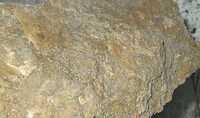
Def. a rare hydrocarbon mineral (CH3)2(CH2)22 or C24H50 is called an evenkite.
Fichtelites
Def. a "rare white monoclinic organic mineral, 7-isopropyl-1,4a-dimethyl-dodecahydro-1H-phenanthrene [C19H34], found in fossilized wood"[2] is called a fichtelite.
Also, occurs in "fossilized pine wood from a peat bog; in organic-rich modern marine sediment."[3]
Simonellites
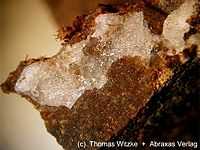
Def. an "orthorhombic-dipyramidal white mineral containing carbon and hydrogen [C19H24]"[4] is called a simonellite.
Kratochvilites
Def. a "rare organic mineral [C14H10 or (C6H4)2CH2, a polymorph of fluorene], an orthorhombic hydrocarbon formed by combustion of coal or pyritic black shale deposits"[5]
Kratochvilites have about 58.3 at % carbon.
Idrialites

Def. a "soft, orthorhombic hydrocarbon [C22H14] mineral, usually greenish-yellow to light brown in colour with bluish fluorescence"[6] is called an idrialite.
Carpathites

Def. a solid, homogeneous, monoclinic (space group P2/c, no. 13, or P21/c, no. 14), naturally occurring, chemical compound with the formula C24H12 that results from natural inorganic processes is called a carpathite.
Def. a "rare hydrocarbon mineral composed of coronene"[7] is called a carpathite.
"Carpathite (aka Karpatite) is a very rare organic species, being a polycyclic aromatic hydrocarbon (PAH). This striking specimen from the old Picacho Mercury Mine of California features a very interesting radial spray of highly lustrous, canary-yellow carpathite lathes to 2.0 cm on starkly contrasting, sparkly, drusy quartz."[8]
Theoretical coals

Def. a "black rock formed from prehistoric plant remains, composed largely of carbon and burned as a fuel"[1] is called a coal.
Def. the process by which plant remains become coal is called coalification.
The chart on the right is an idealized classification of coals from peat through anthracite using total water content (%), energy content (kJ/Kg), volatiles, and surface reflectivity.
Coal gases
Def. a mixture of gases (chiefly hydrogen, methane, and carbon monoxide) obtained by the destructive distillation of coal, or gas given off when coal is burned, is called coal gas.
Petroleums
Def. a "flammable liquid ranging in color from clear to very dark brown and black, consisting mainly of hydrocarbons, occurring naturally in deposits under the Earth's surface"[9] is called a petroleum.
Coal tars

Def. a "black, oily, sticky, viscous substance, consisting mainly of hydrocarbons derived from organic materials such as wood, peat, or coal"[10] is called a tar.
Def. a thick black liquid produced by the destructive distillation of bituminous coal is called a coal tar.
It contains at least benzene, naphthalene, phenols, and aniline.
Naphthas
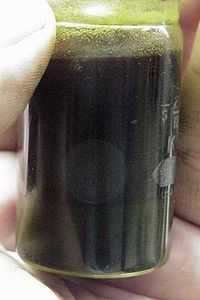
Def. any "of a wide variety of aliphatic or aromatic liquid hydrocarbon mixtures distilled from petroleum or coal tar"[11] is called a naphtha.
Malthas
Def. a black viscid substance intermediate between petroleum and asphalt is called a maltha, or malthite.
Bitumens
Def. a black viscous mixture of hydrocarbons obtained naturally is called a bitumen.
In the image on the right, bitumen occurs with lussatite, an opal.
Pitches
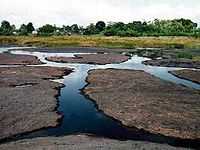
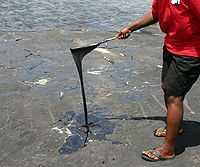
Def. a "dark, extremely viscous material remaining in still after distilling crude oil and tar"[12] is called a pitch.
Asphalts
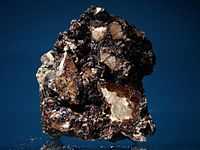
Def. a "sticky, black and highly viscous liquid or semi-solid, composed almost entirely of bitumen, that is present in most crude petroleums and in some natural deposits"[13] is called an asphalt.
Zietrisikites
Def. a natural, waxy hydrocarbon mineraloid is called a zietrisikite.
Ozocerites

Def. a natural dark, or black, odoriferous mineraloid wax is called ozokerite, or ozocerite.
Ambers


Def. a "hard, generally yellow to brown translucent fossil resin"[14] is called an amber.
Peats
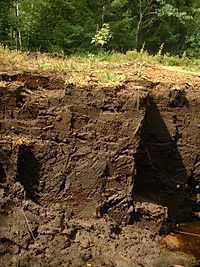
Def. soil "formed of dead but not fully decayed plants found in bog areas"[15] is called peat.
Def. a brown, soil-like material characteristic of boggy, acid ground, consisting of partly decomposed vegetable matter, is called a peat.
Lignites

Def. a "low-grade, brownish-black coal"[16] is called a lignite.
Jets
Def. a "hard, black form of coal"[17], specifically lignite is called a jet.
Bituminous coals
Def. a black coal having a relatively high volatile content is called a bituminous coal.
Anthracites
Def. a "form of carbonized ancient plants; the hardest and cleanest-burning of all the coals; hard coal"[18] is called anthracite.
Def. a coal of a hard variety that contains relatively pure carbon is called an anthracite.
Cokes
Def. a solid "residue from roasting coal"[19] is called a coke.
Fossils
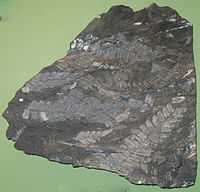
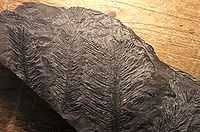
Neuropteris, a fern, leaf impressions and fossils occur in bituminous coal such as in the image on the right. These coal seams and strata are dated to the Carboniferous period.
The Lepidodendrales, quillwort-like large tree-like plants from the Carboniferous also left fossils in bituminous coal as on the left.
Rocky objects
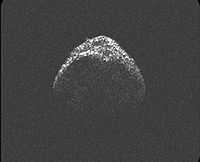
A rocky object is any object, including astronomical objects, composed of one or more types of rocks.
Coal balls

Def. a "nodule of plant material permeated with minerals found mostly in bituminous and anthracite coal seams"[20] is called a coal ball.
Coal seams
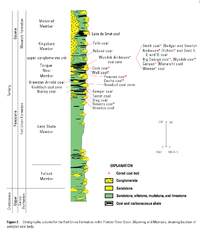
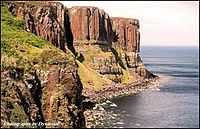
Def. a "stratum of coal between strata of other rocks"[21] is called a coal seam.
Both the Paleocene and Eocene of the Tertiary have coal seams in their stratigraphy, shown in the image on the right, of the Powder River Basin.
On the left is an image of coal seams in the strata of Roome Bay, Scotland.
Tertiary
The Tertiary Period extends from 65.5 ± 0.3 to 2.588 ± 0.005 x 106 b2k.
Lower Tertiary

The Yellowstone Basin in the lower Tertiary has coal seams such as the one imaged on the right, about 8 m thick.
Cretaceous

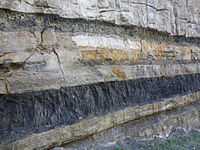
"The Cretaceous period is the third and final period in the Mesozoic Era. It began 145.5 million years ago after the Jurassic Period and ended 65.5 million years ago, before the Paleogene Period of the Cenozoic Era."[22]
The Pine Ridge section of the Late Cretaceous on the right contains coal seams.
The second image on the right exhibits an anthracite coal seam between Cretaceous sandstone strata from Central Utah, USA.
Coal measures
Def. a series of strata of the Carboniferous period, including coal seams, is called coal measures.
Coalfields
Def. an extensive area containing a number of underground coal deposits is called a coalfield.
Peatlands
Def. land consisting largely of beat or peat bogs is called a peatland.
Original research
- See also: Original research inquiry and Research
Hypothesis:
- There is at least one coal seam in each geologic period.
- See also: Control groups, Proof of concept, and Proof of technology
See also
References
- 1 2 "coal, In: Wiktionary". San Francisco, California: Wikimedia Foundation, Inc. 1 January 2015. Retrieved 2015-01-05.
- ↑ "fichtelite, In: Wiktionary". San Francisco, California: Wikimedia Foundation, Inc. 29 May 2014. Retrieved 2015-01-09.
- ↑ R. Ruff (2005). "Fichtelite". Mineral Data Publishing. Retrieved 2015-01-09.
- ↑ "simonellite, In: Wiktionary". San Francisco, California: Wikimedia Foundation, Inc. 19 June 2013. Retrieved 2015-01-09.
- ↑ "kratochvilite, In: Wiktionary". San Francisco, California: Wikimedia Foundation, Inc. 19 June 2013. Retrieved 2015-01-09.
- ↑ "idrialite, In: Wiktionary". San Francisco, California: Wikimedia Foundation, Inc. 20 June 2013. Retrieved 2015-01-09.
- ↑ "carpathite, In: Wiktionary". San Francisco, California: Wikimedia Foundation, Inc. 18 June 2013. Retrieved 2015-01-09.
- ↑ Rob Lavinsky (20 October 2009). "Carpathite". Mindat.org. Retrieved 2015-01-09.
- ↑ "petroleum, In: Wiktionary". San Francisco, California: Wikimedia Foundation, Inc. 16 July 2014. Retrieved 2015-01-09.
- ↑ "tar, In: Wiktionary". San Francisco, California: Wikimedia Foundation, Inc. 5 January 2015. Retrieved 2015-01-09.
- ↑ "naphtha, In: Wiktionary". San Francisco, California: Wikimedia Foundation, Inc. 16 December 2014. Retrieved 2015-01-09.
- ↑ "pitch, In: Wiktionary". San Francisco, California: Wikimedia Foundation, Inc. 12 December 2014. Retrieved 2015-01-10.
- ↑ "asphalt, In: Wiktionary". San Francisco, California: Wikimedia Foundation, Inc. 20 October 2014. Retrieved 2015-01-09.
- ↑ "amber, In: Wiktionary". San Francisco, California: Wikimedia Foundation, Inc. 19 December 2014. Retrieved 2015-01-09.
- ↑ "peat, In: Wiktionary". San Francisco, California: Wikimedia Foundation, Inc. 9 January 2015. Retrieved 2015-01-09.
- ↑ "lignite, In: Wiktionary". San Francisco, California: Wikimedia Foundation, Inc. 16 December 2014. Retrieved 2015-01-09.
- ↑ "jet, In: Wiktionary". San Francisco, California: Wikimedia Foundation, Inc. 15 November 2014. Retrieved 2015-01-10.
- ↑ "anthracite, In: Wiktionary". San Francisco, California: Wikimedia Foundation, Inc. 30 January 2015. Retrieved 2015-02-09.
- ↑ "coke, In: Wiktionary". San Francisco, California: Wikimedia Foundation, Inc. 15 December 2014. Retrieved 2015-01-09.
- ↑ "coal ball, In: Wiktionary". San Francisco, California: Wikimedia Foundation, Inc. 10 November 2012. Retrieved 2015-01-09.
- ↑ "coal seam, In: Wiktionary". San Francisco, California: Wikimedia Foundation, Inc. 8 October 2013. Retrieved 2015-01-09.
- ↑ Gaidheal1 (May 16, 2012). "Cretaceous Period, In: Wikiversity". Retrieved 2012-07-24.
External links
![]() This is a research project at http://en.wikiversity.org
This is a research project at http://en.wikiversity.org
| |
Educational level: this is a research resource. |
| |
Resource type: this resource is an article. |
| |
Resource type: this resource contains a lecture or lecture notes. |
| |
Subject classification: this is a Geology resource. |